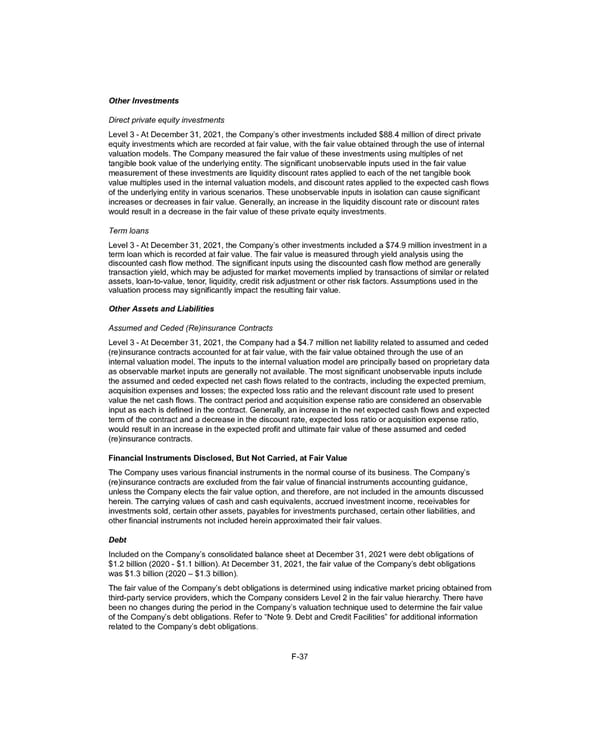Other Investments Direct private equity investments Level 3 - At December 31, 2021, the Company’s other investments included $88.4 million of direct private equity investments which are recorded at fair value, with the fair value obtained through the use of internal valuation models. The Company measured the fair value of these investments using multiples of net tangible book value of the underlying entity. The significant unobservable inputs used in the fair value measurement of these investments are liquidity discount rates applied to each of the net tangible book value multiples used in the internal valuation models, and discount rates applied to the expected cash flows of the underlying entity in various scenarios. These unobservable inputs in isolation can cause significant increases or decreases in fair value. Generally, an increase in the liquidity discount rate or discount rates would result in a decrease in the fair value of these private equity investments. Term loans Level 3 - At December 31, 2021, the Company’s other investments included a $74.9 million investment in a term loan which is recorded at fair value. The fair value is measured through yield analysis using the discounted cash flow method. The significant inputs using the discounted cash flow method are generally transaction yield, which may be adjusted for market movements implied by transactions of similar or related assets, loan-to-value, tenor, liquidity, credit risk adjustment or other risk factors. Assumptions used in the valuation process may significantly impact the resulting fair value . Other Assets and Liabilities Assumed and Ceded (Re)insurance Contracts Level 3 - At December 31, 2021, the Company had a $4.7 million net liability related to assumed and ceded (re)insurance contracts accounted for at fair value, with the fair value obtained through the use of an internal valuation model. The inputs to the internal valuation model are principally based on proprietary data as observable market inputs are generally not available. The most significant unobservable inputs include the assumed and ceded expected net cash flows related to the contracts, including the expected premium, acquisition expenses and losses; the expected loss ratio and the relevant discount rate used to present value the net cash flows. The contract period and acquisition expense ratio are considered an observable input as each is defined in the contract. Generally, an increase in the net expected cash flows and expected term of the contract and a decrease in the discount rate, expected loss ratio or acquisition expense ratio, would result in an increase in the expected profit and ultimate fair value of these assumed and ceded (re)insurance contracts. Financial Instruments Disclosed, But Not Carried, at Fair Value The Company uses various financial instruments in the normal course of its business. The Company’s (re)insurance contracts are excluded from the fair value of financial instruments accounting guidance, unless the Company elects the fair value option, and therefore, are not included in the amounts discussed herein. The carrying values of cash and cash equivalents, accrued investment income, receivables for investments sold, certain other assets, payables for investments purchased, certain other liabilities, and other financial instruments not included herein approximated their fair values. Debt Included on the Company’s consolidated balance sheet at December 31, 2021 were debt obligations of $1.2 billion (2020 - $1.1 billion). At December 31, 2021, the fair value of the Company’s debt obligations was $1.3 billion ( 2020 – $1.3 billion). The fair value of the Company’s debt obligations is determined using indicative market pricing obtained from third-party service providers, which the Company considers Level 2 in the fair value hierarchy. There have been no changes during the period in the Company’s valuation technique used to determine the fair value of the Company’s debt obligations. Refer to “Note 9. Debt and Credit Facilities” for additional information related to the Company’s debt obligations. F-37
 2021 Annual Report Page 179 Page 181
2021 Annual Report Page 179 Page 181